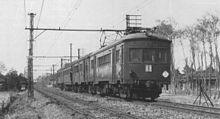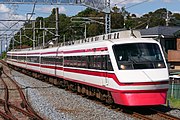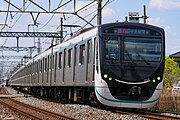This article needs additional citations for
verification. (December 2009) |
| Tobu Isesaki Line | |||||||||||||||||||||||||||||||||||||||||||||||||||||||||||||||||||||||||||||||||||||||||||||||||||||||||||||||||||||||||||||||||||||||||||||||||||||||||||||||||||||||||||||||||||||||||||||||||||||||||||||||||||||||||||||||||||||||||||||||||||||||||||||||||||||||||||||||||||||||||||||||||||||||||||||||||||||||||||||||||||||||||||||||||||||
|---|---|---|---|---|---|---|---|---|---|---|---|---|---|---|---|---|---|---|---|---|---|---|---|---|---|---|---|---|---|---|---|---|---|---|---|---|---|---|---|---|---|---|---|---|---|---|---|---|---|---|---|---|---|---|---|---|---|---|---|---|---|---|---|---|---|---|---|---|---|---|---|---|---|---|---|---|---|---|---|---|---|---|---|---|---|---|---|---|---|---|---|---|---|---|---|---|---|---|---|---|---|---|---|---|---|---|---|---|---|---|---|---|---|---|---|---|---|---|---|---|---|---|---|---|---|---|---|---|---|---|---|---|---|---|---|---|---|---|---|---|---|---|---|---|---|---|---|---|---|---|---|---|---|---|---|---|---|---|---|---|---|---|---|---|---|---|---|---|---|---|---|---|---|---|---|---|---|---|---|---|---|---|---|---|---|---|---|---|---|---|---|---|---|---|---|---|---|---|---|---|---|---|---|---|---|---|---|---|---|---|---|---|---|---|---|---|---|---|---|---|---|---|---|---|---|---|---|---|---|---|---|---|---|---|---|---|---|---|---|---|---|---|---|---|---|---|---|---|---|---|---|---|---|---|---|---|---|---|---|---|---|---|---|---|---|---|---|---|---|---|---|---|---|---|---|---|---|---|---|---|---|---|---|---|---|---|---|---|---|---|---|---|---|---|---|---|---|---|---|---|---|---|---|---|---|---|---|---|---|---|---|---|---|---|---|---|---|---|---|---|---|---|---|---|---|---|---|---|---|---|---|---|---|---|---|---|---|---|---|---|---|
| TI | |||||||||||||||||||||||||||||||||||||||||||||||||||||||||||||||||||||||||||||||||||||||||||||||||||||||||||||||||||||||||||||||||||||||||||||||||||||||||||||||||||||||||||||||||||||||||||||||||||||||||||||||||||||||||||||||||||||||||||||||||||||||||||||||||||||||||||||||||||||||||||||||||||||||||||||||||||||||||||||||||||||||||||||||||||||
 Tobu Railway 200 series | |||||||||||||||||||||||||||||||||||||||||||||||||||||||||||||||||||||||||||||||||||||||||||||||||||||||||||||||||||||||||||||||||||||||||||||||||||||||||||||||||||||||||||||||||||||||||||||||||||||||||||||||||||||||||||||||||||||||||||||||||||||||||||||||||||||||||||||||||||||||||||||||||||||||||||||||||||||||||||||||||||||||||||||||||||||
| Overview | |||||||||||||||||||||||||||||||||||||||||||||||||||||||||||||||||||||||||||||||||||||||||||||||||||||||||||||||||||||||||||||||||||||||||||||||||||||||||||||||||||||||||||||||||||||||||||||||||||||||||||||||||||||||||||||||||||||||||||||||||||||||||||||||||||||||||||||||||||||||||||||||||||||||||||||||||||||||||||||||||||||||||||||||||||||
| Native name | 東武伊勢崎線 | ||||||||||||||||||||||||||||||||||||||||||||||||||||||||||||||||||||||||||||||||||||||||||||||||||||||||||||||||||||||||||||||||||||||||||||||||||||||||||||||||||||||||||||||||||||||||||||||||||||||||||||||||||||||||||||||||||||||||||||||||||||||||||||||||||||||||||||||||||||||||||||||||||||||||||||||||||||||||||||||||||||||||||||||||||||
| Owner | Tobu Railway | ||||||||||||||||||||||||||||||||||||||||||||||||||||||||||||||||||||||||||||||||||||||||||||||||||||||||||||||||||||||||||||||||||||||||||||||||||||||||||||||||||||||||||||||||||||||||||||||||||||||||||||||||||||||||||||||||||||||||||||||||||||||||||||||||||||||||||||||||||||||||||||||||||||||||||||||||||||||||||||||||||||||||||||||||||||
| Locale | Kantō | ||||||||||||||||||||||||||||||||||||||||||||||||||||||||||||||||||||||||||||||||||||||||||||||||||||||||||||||||||||||||||||||||||||||||||||||||||||||||||||||||||||||||||||||||||||||||||||||||||||||||||||||||||||||||||||||||||||||||||||||||||||||||||||||||||||||||||||||||||||||||||||||||||||||||||||||||||||||||||||||||||||||||||||||||||||
| Termini | |||||||||||||||||||||||||||||||||||||||||||||||||||||||||||||||||||||||||||||||||||||||||||||||||||||||||||||||||||||||||||||||||||||||||||||||||||||||||||||||||||||||||||||||||||||||||||||||||||||||||||||||||||||||||||||||||||||||||||||||||||||||||||||||||||||||||||||||||||||||||||||||||||||||||||||||||||||||||||||||||||||||||||||||||||||
| Stations | 26 | ||||||||||||||||||||||||||||||||||||||||||||||||||||||||||||||||||||||||||||||||||||||||||||||||||||||||||||||||||||||||||||||||||||||||||||||||||||||||||||||||||||||||||||||||||||||||||||||||||||||||||||||||||||||||||||||||||||||||||||||||||||||||||||||||||||||||||||||||||||||||||||||||||||||||||||||||||||||||||||||||||||||||||||||||||||
| Website | https://www.tobu.co.jp/en/ | ||||||||||||||||||||||||||||||||||||||||||||||||||||||||||||||||||||||||||||||||||||||||||||||||||||||||||||||||||||||||||||||||||||||||||||||||||||||||||||||||||||||||||||||||||||||||||||||||||||||||||||||||||||||||||||||||||||||||||||||||||||||||||||||||||||||||||||||||||||||||||||||||||||||||||||||||||||||||||||||||||||||||||||||||||||
| Service | |||||||||||||||||||||||||||||||||||||||||||||||||||||||||||||||||||||||||||||||||||||||||||||||||||||||||||||||||||||||||||||||||||||||||||||||||||||||||||||||||||||||||||||||||||||||||||||||||||||||||||||||||||||||||||||||||||||||||||||||||||||||||||||||||||||||||||||||||||||||||||||||||||||||||||||||||||||||||||||||||||||||||||||||||||||
| Type | Commuter rail | ||||||||||||||||||||||||||||||||||||||||||||||||||||||||||||||||||||||||||||||||||||||||||||||||||||||||||||||||||||||||||||||||||||||||||||||||||||||||||||||||||||||||||||||||||||||||||||||||||||||||||||||||||||||||||||||||||||||||||||||||||||||||||||||||||||||||||||||||||||||||||||||||||||||||||||||||||||||||||||||||||||||||||||||||||||
| Depot(s) | Tatebayashi | ||||||||||||||||||||||||||||||||||||||||||||||||||||||||||||||||||||||||||||||||||||||||||||||||||||||||||||||||||||||||||||||||||||||||||||||||||||||||||||||||||||||||||||||||||||||||||||||||||||||||||||||||||||||||||||||||||||||||||||||||||||||||||||||||||||||||||||||||||||||||||||||||||||||||||||||||||||||||||||||||||||||||||||||||||||
| Daily ridership | 843,495 (2010) [1] | ||||||||||||||||||||||||||||||||||||||||||||||||||||||||||||||||||||||||||||||||||||||||||||||||||||||||||||||||||||||||||||||||||||||||||||||||||||||||||||||||||||||||||||||||||||||||||||||||||||||||||||||||||||||||||||||||||||||||||||||||||||||||||||||||||||||||||||||||||||||||||||||||||||||||||||||||||||||||||||||||||||||||||||||||||||
| History | |||||||||||||||||||||||||||||||||||||||||||||||||||||||||||||||||||||||||||||||||||||||||||||||||||||||||||||||||||||||||||||||||||||||||||||||||||||||||||||||||||||||||||||||||||||||||||||||||||||||||||||||||||||||||||||||||||||||||||||||||||||||||||||||||||||||||||||||||||||||||||||||||||||||||||||||||||||||||||||||||||||||||||||||||||||
| Opened | 27 August 1899 | ||||||||||||||||||||||||||||||||||||||||||||||||||||||||||||||||||||||||||||||||||||||||||||||||||||||||||||||||||||||||||||||||||||||||||||||||||||||||||||||||||||||||||||||||||||||||||||||||||||||||||||||||||||||||||||||||||||||||||||||||||||||||||||||||||||||||||||||||||||||||||||||||||||||||||||||||||||||||||||||||||||||||||||||||||||
| Technical | |||||||||||||||||||||||||||||||||||||||||||||||||||||||||||||||||||||||||||||||||||||||||||||||||||||||||||||||||||||||||||||||||||||||||||||||||||||||||||||||||||||||||||||||||||||||||||||||||||||||||||||||||||||||||||||||||||||||||||||||||||||||||||||||||||||||||||||||||||||||||||||||||||||||||||||||||||||||||||||||||||||||||||||||||||||
| Line length | 73.5 km (45.7 mi) | ||||||||||||||||||||||||||||||||||||||||||||||||||||||||||||||||||||||||||||||||||||||||||||||||||||||||||||||||||||||||||||||||||||||||||||||||||||||||||||||||||||||||||||||||||||||||||||||||||||||||||||||||||||||||||||||||||||||||||||||||||||||||||||||||||||||||||||||||||||||||||||||||||||||||||||||||||||||||||||||||||||||||||||||||||||
| Track gauge | 1,067 mm (3 ft 6 in) | ||||||||||||||||||||||||||||||||||||||||||||||||||||||||||||||||||||||||||||||||||||||||||||||||||||||||||||||||||||||||||||||||||||||||||||||||||||||||||||||||||||||||||||||||||||||||||||||||||||||||||||||||||||||||||||||||||||||||||||||||||||||||||||||||||||||||||||||||||||||||||||||||||||||||||||||||||||||||||||||||||||||||||||||||||||
| Electrification | 1,500 V DC | ||||||||||||||||||||||||||||||||||||||||||||||||||||||||||||||||||||||||||||||||||||||||||||||||||||||||||||||||||||||||||||||||||||||||||||||||||||||||||||||||||||||||||||||||||||||||||||||||||||||||||||||||||||||||||||||||||||||||||||||||||||||||||||||||||||||||||||||||||||||||||||||||||||||||||||||||||||||||||||||||||||||||||||||||||||
| Operating speed | 110 km/h (68 mph) | ||||||||||||||||||||||||||||||||||||||||||||||||||||||||||||||||||||||||||||||||||||||||||||||||||||||||||||||||||||||||||||||||||||||||||||||||||||||||||||||||||||||||||||||||||||||||||||||||||||||||||||||||||||||||||||||||||||||||||||||||||||||||||||||||||||||||||||||||||||||||||||||||||||||||||||||||||||||||||||||||||||||||||||||||||||
| |||||||||||||||||||||||||||||||||||||||||||||||||||||||||||||||||||||||||||||||||||||||||||||||||||||||||||||||||||||||||||||||||||||||||||||||||||||||||||||||||||||||||||||||||||||||||||||||||||||||||||||||||||||||||||||||||||||||||||||||||||||||||||||||||||||||||||||||||||||||||||||||||||||||||||||||||||||||||||||||||||||||||||||||||||||
The Tobu Isesaki Line (東武伊勢崎線, Tōbu Isesaki-sen) is a Japanese railway line operated by the private railway company Tobu Railway, extending from Tōbu-Dōbutsu-Kōen Station in Saitama to Isesaki Station in Gunma Prefecture. The Isesaki Line can refer to the entire section between Asakusa - Isesaki and Oshiage - Hikifune, but from March 2012, the 41.0 km (25.5 mi) section south of Tōbu-Dōbutsu-Kōen was branded as the Tobu Skytree Line in conjunction with the opening of the Tokyo Skytree tower.
Descriptions
- Track
- single: Tatebayashi − Isesaki 39.9 km (24.8 mi)
- double: the rest
Operation
Service patterns
Stops and operated sections are as of 2023, February 15.
- Local (普通, Futsū) (announced as Kakueki Teisha (各駅停車) or kakutei (各停) for short) (L)
-
- Tōbu-Dōbutsu-Kōen − Ōta. Connection with Express. Three per hour, with one between Kuki and Tatebayashi.
- Ōta − Isesaki. One per hour per direction, conductorless.
- Section Semi-Express (区間準急, Kukan Junkyū) (SSE)
- Between Asakusa and Tōbu-Dōbutsu Kōen, Kuki or Minami-Kurihashi on Nikkō Line.
- Semi-Express (準急, Junkyū) (SmE)
- Early morning and late night. Down to Tōbu-Dōbutsu-Kōen, Kuki or to Minami-Kurihashi on the Nikkō Line through from Chūō-Rinkan of Tokyu Den-en-toshi Line via Hanzōmon Line. 10 cars.
- Section Express (区間急行, Kukan Kyūkō) (SE)
- Between Asakusa and Tōbu-Dōbutsu-Kōen, Tatebayashi or Ōta.
- Express (急行, Kyūkō) (Ex)
- From morning to night. Down to Tōbu-Dōbutsu-Kōen, Kuki (nearly half to Minami-Kurihashi on the Nikkō Line), through from Chūō-Rinkan on the Tokyu Den-en-toshi Line via Hanzōmon Line. 10 cars.
- Limited Express (特急, Tokkyū) (LE)
- Stops not shown for now. Charged for seat reservation and rapid service. Mainly through to the Nikkō Line for the Nikko area named Kegon (けごん) and Kinu (きぬ). Some through to Isesaki from Asakusa, sole direct service named Ryōmō (りょうもう). The 70090 Series Services runs through to Ebisu from Kuki, Home liner service named TH Liner.
Stations
- O: Stop
- *1: To/from Asakusa on the Tobu Skytree Line section of the Isesaki Line.
- *2: To/from Chūō-Rinkan on Tokyu Den-en-toshi Line via Tokyo Metro Hanzomon Line
- For the section between Tōbu-Dōbutsu-Kōen and Asakusa, see Tobu Skytree Line.
| No. | Station | L | SSE | SmE | SE | Ex | Transfers | Location | ||
|---|---|---|---|---|---|---|---|---|---|---|
| TS30 | Tōbu-Dōbutsu-Kōen | 東武動物公園 | O | O *1 |
O *2 |
O *1 |
O *2 |
|
Miyashiro | Saitama |
| TI01 | Wado | 和戸 | O | O | O | O | O | |||
| TI02 | Kuki | 久喜 | O | O | O | O | O | JU Utsunomiya Line | Kuki | |
| TI03 | Washinomiya | 鷲宮 | O | O | O | |||||
| TI04 | Hanasaki | 花崎 | O | O | O | Kazo | ||||
| TI05 | Kazo | 加須 | O | O | O | |||||
| TI06 | Minami-Hanyū | 南羽生 | O | O | O | Hanyū | ||||
| TI07 | Hanyū | 羽生 | O | O | O | ■ Chichibu Main Line | ||||
| TI08 | Kawamata | 川俣 | O | O | O | Meiwa | Gunma | |||
| TI09 | Morinji-mae | 茂林寺前 | O | O | O | Tatebayashi | ||||
| TI10 | Tatebayashi | 館林 | O | O | O | |||||
| TI11 | Tatara | 多々良 | O | |||||||
| TI12 | Agata | 県 | O | Ashikaga | Tochigi | |||||
| TI13 | Fukui | 福居 | O | |||||||
| TI14 | Tōbu-Izumi | 東武和泉 | O | |||||||
| TI15 | Ashikagashi | 足利市 | O | |||||||
| TI16 | Yashū-yamabe | 野州山辺 | O | |||||||
| TI17 | Niragawa | 韮川 | O | Ōta | Gunma | |||||
| TI18 | Ōta | 太田 | O | |||||||
| TI19 | Hosoya | 細谷 | O | |||||||
| TI20 | Kizaki | 木崎 | O | |||||||
| TI21 | Serada | 世良田 | O | |||||||
| TI22 | Sakaimachi | 境町 | O | Isesaki | ||||||
| TI23 | Gōshi | 剛志 | O | |||||||
| TI24 | Shin-Isesaki | 新伊勢崎 | O | |||||||
| TI25 | Isesaki | 伊勢崎 | O | ■ Ryomo Line | ||||||
Rolling stock
Current
- Tobu 200 series
- Tobu 500 series
- Tobu 10000 series
- Tobu 50000 series
- Tobu 50050 series
- Tobu 70090 series ( TH Liner)
- Tokyu 2020 series
- Tokyu 5000 series
- Tokyo Metro 18000 series
- Tokyo Metro 8000 series
- Tokyo Metro 08 series
-
Tobu 200 series
-
Tobu 10000 series
-
Tobu 50050 series
-
Tokyu 2020 series
-
Tokyu 5000 series
-
Tokyu 8500 series
-
Tokyo Metro 8000 series
Former
- Tokyu 8500 series (1975-2023)
- Tobu 30000 series
History


The first section of the Isesaki Line was opened by the present company in 1899 between Kita-Senju and Kuki utilising steam motive power. In 1902, Tobu extended the line south to have a maritime connection at present Tokyo Skytree (then Azumabashi (吾妻橋), later renamed Asakusa) in downtown Tokyo, and north to Kazo. The following year a further northern extension to Kawamata (then on the south bank of Tone River) was opened. Further northward extension progressed, and in 1910 the line arrived at Isesaki. In 1931, a bridge over the Sumida River was built and present Asakusa Station (then Asakusa Kaminarimon (浅草雷門)) opened as part of the department store building, the entire line being completed.
The Asakusa to Nishiarai section was double-tracked in 1912, and the rest of the line was double-tracked between 1920 and 1927, except for the Hanyu to Kawamata section, which was double-tracked when a second bridge was built over the Tonegawa in 1992.
Electrification was begun in 1924 on the section of Asakusa and Nishiarai, and in 1927 completed as far as Isesaki. The distance of over 100 km (62 mi) was then one of the longest electrified railway lines together with the present Kintetsu Osaka Line and Yamada Lines.
After World War II, the Tobu Lines had no connection to the Yamanote Line or other major lines of the then Japanese National Railways (JNR) to offer efficient transfers to central Tokyo. The sole connection was with the Jōban Line at Kitasenju, which offered poor access to central Tokyo. To solve the inefficiencies of transfers at Kitasenju and notoriously narrow Asakusa, in 1962, the Hibiya Line of the then Teito Rapid Transport Authority (帝都高速度交通営団, Teito Kōsokudo Kōtsū Eidan), known as TRTA, present Tokyo Metro) was built, connecting at Kitasenju.
Further growing traffic required Tobu to build a second through line to Tokyo Metro Hanzomon Line in the 1990s. In 2003, the company built new tracks from Hikifune to connect at Oshiage, officially an annex station of Tokyo Skytree.
From the 3 March 2006, timetable revision, less than half of trains originated or terminated at Asakusa, with more trains operating through to Tokyo Metro subway lines.
From 17 March 2012, the section south of Tōbu-Dōbutsu-Kōen was rebranded as the Tobu Skytree Line.
References
This article incorporates material from the corresponding article in the Japanese Wikipedia
- ^ Tobu ridership in 2010 Train Media (sourced from Tobu) Retrieved May 28, 2012.
External links
- Tobu Railway Isesaki Line information page (in Japanese)






